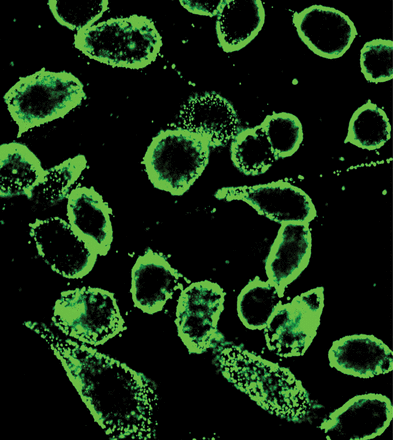AACR Journals Editors’ Picks for July
This month, the “must read” articles from the portfolio of journals published by the AACR include an estimation of the cost of cancer care in the U.S. in 2030, the development of a machine-learning model to determine the clinical significance of variants of the tumor suppressor gene PTEN, and results from two clinical trials, along with other studies. In addition to the eight peer-reviewed scientific journals highlighted here, the AACR published its inaugural issue of Blood Cancer Discovery this month. All articles in this issue are freely available.
Journal: Cancer Research (July 1 issue)
A Premalignant Cell-Based Model for Functionalization and Classification of PTEN Variants
PTEN is a frequently mutated tumor suppressor gene, but the impacts of several recently identified clinical variants on pathogenicity remain uncharacterized. Here, the authors developed a cell-based assay to evaluate the pathogenicity of the genetic variants of PTEN. The researchers expressed individual variants of PTEN in PTEN-deficient normal mammary epithelial cells and evaluated whether each variant would promote spheroid formation, an indication of pathogenicity. They used the assay to functionally characterize 47 PTEN variants as either benign or pathogenic. Using data from the cell-based assay, the researchers developed a machine-learning model that could accurately predict whether a PTEN variant was benign or pathogenic 87.5 percent of the time, outperforming existing computational models. The authors suggest that their assay-based model could be an alternative method for determining the clinical significance of PTEN variants. This article was featured on the cover of the July 1 issue.
Journal: Cancer Research (July 15 issue)
Tumor endothelial cells (TECs), or the cells that line tumor-associated blood vessels, can develop resistance to anticancer therapies and thereby allow tumor cells to survive and metastasize. Previous work has demonstrated that TECs express high levels of the drug efflux transporter ABCB1, which can acquire resistance to anticancer drugs such as paclitaxel, and that this resistance can be diminished by combination therapy with an ABCB1 inhibitor in a melanoma xenograft model. In this study, the authors evaluated clinical urothelial carcinoma tissues before and after first-line chemotherapy and found that the ratio of ABCB1-positive TECs increased following treatment in the majority of samples. Further, the expression of ABCB1 in TECs correlated with IL8 expression in tumor cells following first-line chemotherapy, both of which correlated with poor prognosis in patients with urothelial carcinoma. In a murine bladder cancer model, the researchers found that the combination of paclitaxel and an ABCB1 inhibitor reduced tumor growth and metastasis when compared with paclitaxel treatment alone. These results suggest that ABCB1 expression can contribute to drug resistance following first-line chemotherapy, and that inhibition of ABCB1 in TECs could overcome drug resistance and improve clinical outcome in patients with urothelial cancer. This article was featured on the cover and was highlighted in the July 15 issue.
Journal: Molecular Cancer Research
The extracellular matrix protein fibrinogen, a key player in blood clot formation, is associated with tumor angiogenesis and metastasis. To better understand how fibrinogen alpha chain (FGA), a component of fibrinogen, mediates growth and metastasis in lung cancer, the study authors used CRISPR/Cas9 to knock out the FGA gene in lung adenocarcinoma cell lines. These knockout cell lines had increased cell proliferation, migration, and invasion, with reduced expression of certain epithelial-mesenchymal transition markers, compared with wild type cells. Administration of FGA inhibited cell proliferation and migration and induced cell apoptosis in the knockout cells. Through functional analysis, the researchers noted a direct interaction between FGA and integrin α5, which regulated the AKT-mTOR signaling pathway in lung adenocarcinoma cells. Further, in mice subcutaneously injected with wild type and FGA knockout lung adenocarcinoma cells, the researchers found that the mice injected with the knockout cells had increased tumor growth and metastasis and increased levels of AKT signaling. These results suggest that loss or disruption of FGA can facilitate lung tumor growth and metastasis through the integrin-AKT signaling pathway. This article was highlighted in the July issue.
Journal: Cancer Prevention Research
Most pancreatic adenocarcinomas (PDAs) develop following activation of the KRAS protein; however, the regulatory mechanisms underlying transformation following KRAS activation remain unclear. Here, the authors examined the impact of microRNAs (miRNAs) in this process. Using a mouse model of PDA tumorigenesis, the authors profiled miRNAs in both premalignant pancreatic intraepithelial neoplasia (PanIN) and PDA. They found that epithelial cells of premalignant ducts exhibited overexpression of miR-21, while cancer-associated fibroblasts in PDA stroma overexpressed miR-224. Overexpression of miR-224 in normal fibroblasts led to increased cellular proliferation, migration, and invasion, while inhibition of miR-21 decreased tumor cell proliferation and improved survival of mice with PDA. Systemic inhibition of miR-21 or miR-224 intercepted progression of early PanIN in mice. Furthermore, examination of patient data from The Cancer Genome Atlas demonstrated that high miR-21 expression correlated with a greater proportion of tumor epithelial cells in patients with PDA. The authors propose that miR-21 may be a useful biomarker for the early detection of PanIN and that inhibition of miR-21 may be effective for intercepting premalignant lesions in patients. This article was featured on the cover of the July issue.
Journal: Cancer Epidemiology, Biomarkers & Prevention
Medical Care Costs Associated with Cancer Survivorship in the United States
As the population in the United States continues to age, the number of individuals with a history of cancer continues to increase. To estimate the cost of cancer-related care in 2015 and 2030, the study authors used information from the Surveillance, Epidemiology, and End Results (SEER)-Medicare database to evaluate costs by cancer site, phases of care, and stage at diagnosis for cancer survivors 65 years and older. Cancer-attributable costs were estimated by comparing costs among patients with a history of cancer with an equivalent number of individuals without a history of cancer. Overall, the researchers found that costs were highest among those who died from cancer in the final year of life, corresponding to $105,500 and $4,200 per patient for medical costs and oral prescription drugs, respectively, with costs varying considerably by cancer site. Further, the authors estimate that the cost of cancer care will increase from $183 billion in 2015 to over $245 billion in 2030, representing a total increase in national cost of 34 percent. “Our projections of the total costs of cancer care are substantial,” noted study author Angela Mariotto, PhD, in an AACR press release. “The number of people diagnosed with cancer increases with age, and an aging population means that the number of cancer survivors will increase, which is accompanied by significant cost.” This article was highlighted in the July issue.
Journal: Molecular Cancer Therapeutics
MMAE Delivery Using the Bicycle Toxin Conjugate BT5528

Antibody-drug conjugates (ADCs) allow for the selective delivery of cytotoxic drugs with the goal of sparing nontarget organs. While this approach has yielded some clinical success, the size of the antibody can limit the efficacy and increase the toxicity of the ADC. In this study, the authors describe a new approach called a Bicycle toxin conjugate (BTC), where the antibody is replaced with a synthetic, structurally contained bicyclic peptide (“Bicycle”) which is attached to a cytotoxic drug. The BTC evaluated in this study, called BT5528, targets the EphA2 receptor, which is overexpressed in a variety of tumor types; the antineoplastic agent used in this approach is monomethyl auristatin E (MMAE). The researchers found that BT5528 was efficacious in xenograft models, with favorable toxicology findings in rats and monkeys. The authors noted that an interventional clinical trial evaluating BT5528 alone and in combination with the checkpoint inhibitor nivolumab (Opdivo) in patients with advanced solid tumors associated with EphA2 expression is currently recruiting. This article was featured on the cover and was highlighted in the July issue.
Journal: Clinical Cancer Research (July 15 issue)
The androgen receptor antagonist apalutamide (Erleada) and the androgen receptor signaling inhibitor abiraterone acetate (Zytiga) provide clinical benefit in patients with metastatic castration-resistant prostate cancer, yet the combination of these two therapeutics has not been studied extensively in this patient population. In this phase Ib clinical trial, the drug-drug interaction of apalutamide and abiraterone acetate in conjunction with prednisone in 57 patients was investigated; roughly half of these patients had been previously treated with abiraterone acetate plus prednisone. The drug combination was well-tolerated, and no significant pharmacokinetic interactions were observed between apalutamide and abiraterone. Based on serial prostate-specific antigen (PSA) monitoring, the combination of apalutamide and abiraterone acetate plus prednisone resulted in potential antitumor activity in 80 percent of patients who had not previously received treatment with an androgen receptor signaling inhibitor and in 14 percent of patients who had received prior treatment with an androgen receptor signaling inhibitor. The authors note that a randomized phase III trial evaluating apalutamide in combination with abiraterone acetate and prednisone in chemotherapy-naïve patients with metastatic castration-resistant prostate cancer is currently ongoing. This article was highlighted in the July 15 issue.
Journal: Clinical Cancer Research (July 1 issue)
Mutations in the KRAS, NRAS, and BRAF proteins can render colorectal cancer cells resistant to radiation therapy. Preclinical studies demonstrated that trametinib, an inhibitor of the downstream MEK protein, sensitized RAS-mutated cancer cells to radiation therapy and suppressed proliferation of KRAS- or BRAF-mutated colon cancer cells. In this phase I clinical trial, the safety and tolerability of trametinib in combination with 5-fluorouracil (5-FU) chemoradiation therapy prior to surgery were examined in patients with locally advanced rectal cancer (LARC). The trial enrolled 19 patients who were at least 18 years old and had stage II or III untreated LARC. Patients received trametinib for five days, after which they began combination treatment with trametinib and 5-FU chemoradiation. One patient experienced a dose-limiting toxicity, which was attributed to chemoradiation. No grade 3 or 4 adverse events were observed. Nine of the 12 patients who received the recommended phase II dose of trametinib experienced tumor downstaging, and three patients had pathologic complete responses at this dose. The authors conclude that trametinib in combination with 5-FU chemoradiation is safe, well tolerated, and shows signs of clinical efficacy. This article was highlighted in the July 1 issue.
Journal: Cancer Discovery

Glioblastoma is difficult to model in vitro due to its genetic heterogeneity and its dynamic nature across cellular states. Current glioblastoma models include glioma spheres, tumor organoids, glioblastoma cerebral organoids (GLICO), and patient-derived xenografts, but their ability to model the cellular states seen in primary tumors remains unclear. Here, the authors compared single-cell RNA sequencing results from each of these models to those of primary tumor cells derived from five patients with glioblastoma. They found that the GLICO model was enriched for neural and oligodendrocyte progenitor-like cells and that it most closely resembled the cellular states found in primary tumors. The diverse cellular states observed in the GLICO model were lost when its cells were re-plated in two-dimensional cell culture. The authors conclude that the tumor microenvironment is needed to maintain the cellular states of primary glioblastomas in this model. This article was highlighted and featured on the cover of the July issue. A commentary on this article can be found here.
Journal: Cancer Immunology Research
Vaccination Against Nonmutated Neoantigens Induced in Recurrent and Future Tumors
The presence of neoantigens contributes to tumor immunogenicity, which is the basis for some immunotherapeutic approaches; however, most patients do not express adequate tumor neoantigens, and recurrent tumors may express different neoantigens than the primary tumor. In this study, the authors evaluated the efficacy of targeting a common set of antigens that are expressed in all tumor cells that have downregulation of the peptide transporter associated with antigen processing (TAP) protein. They developed a two-pronged vaccination strategy that involved (1) siRNA-mediated depletion of TAP in dendritic cells to stimulate a T-cell response against a common set of antigens and (2) siRNA-mediated depletion of TAP in tumor cells to induce expression of the antigens in the tumor. The authors found that this strategy inhibited primary and recurrent tumor growth in mice. Furthermore, siRNA-mediated depletion of TAP in human dendritic cells stimulated CD8+ T cells to recognize TAP-depleted human tumor cells in in vitro experiments. The authors propose that this strategy could help overcome the challenges associated with vaccinating against unique tumor neoantigens. This article was featured on the cover of the July issue.



